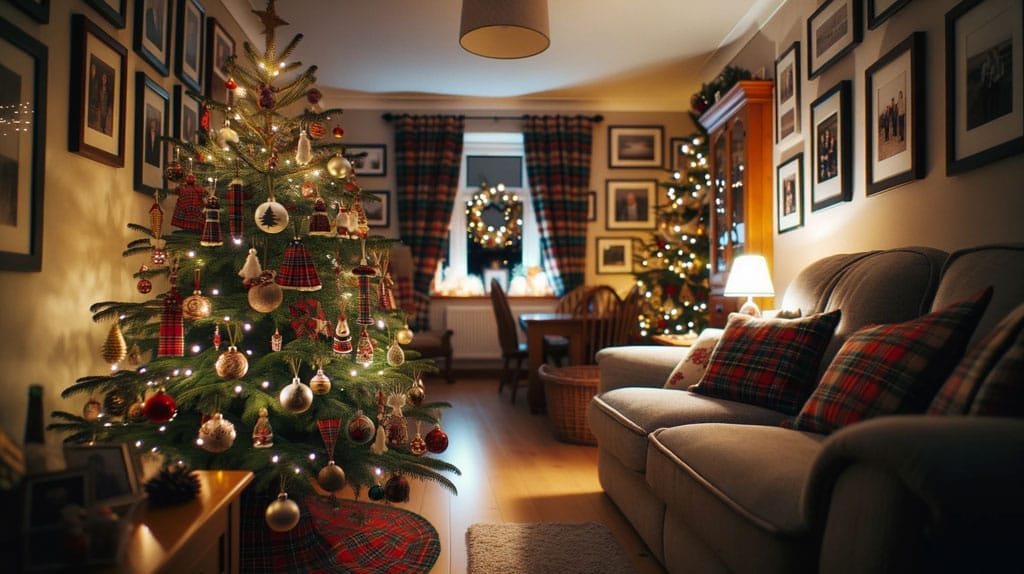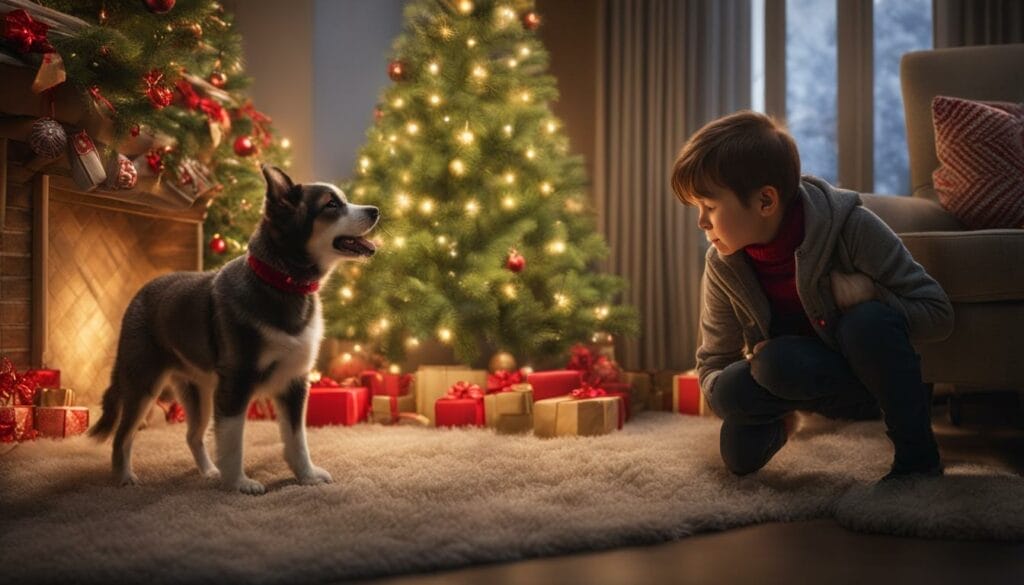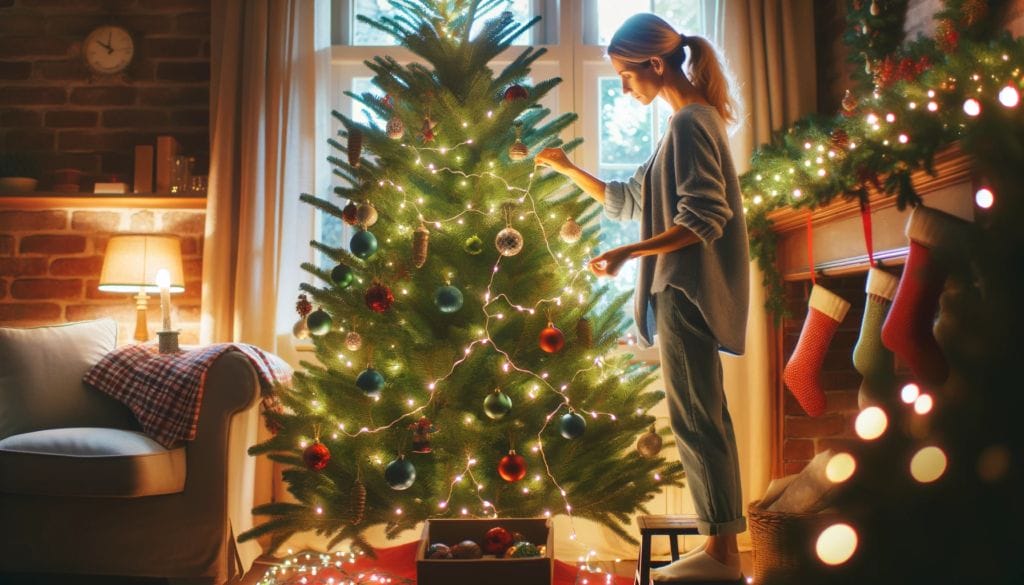Essential Christmas Tree Safety Tips for a Festive Season
As the festive season approaches, twinkling lights and beautifully adorned Christmas trees become the centerpiece in homes. But amidst the merriment, it’s crucial to prioritize safety.

Every year, holiday decorations contribute to accidents and fires. To ensure that your home remains a safe haven for holiday cheer, we’re going to walk you through essential Christmas tree safety tips.
Quick Reference Christmas Tree Safety Tips
| Safety Tip | Description | Reason |
|---|---|---|
| Choose a Fire-Resistant Tree | Opt for trees labeled as fire-resistant. | Reduces the risk of fire, especially important with electrical decorations. |
| Secure Base and Tree Stand | Ensure the tree stand is sturdy and properly fitted. | Prevents the tree from tipping over and causing injury or damage. |
| Regular Watering (For Real Trees) | Keep the tree base immersed in water. | A dry tree is more prone to catching fire from heat sources or electrical malfunctions. |
| Use Non-Flammable Decorations | Decorate with materials that won’t ignite easily. | Minimizes the risk of decorations catching fire from lights or candles. |
| Check LED Lights and Electrical Cords | Inspect for damages before use. | Prevents electrical fires due to faulty lights or frayed cords. |
| Position Away from Heat Sources | Place your tree away from fireplaces, heaters, and candles. | Heat sources can dry out the tree quickly and potentially start a fire. |
| Install Smoke Detectors | Ensure working smoke detectors are installed near the tree. | Early detection of smoke can be crucial to preventing a full-blown fire. |
| Ready Fire Extinguisher | Keep an extinguisher near the tree area. | Allows for quick action if a fire starts. |
| Fire Escape Plan | Have a clear escape plan that accounts for the tree. | Ensures everyone knows how to exit safely in case of a fire. |
| Childproofing Measures | Use safe ornaments and keep hazardous items out of reach. | Protects children from potential harm from small or sharp decorations. |
| Pet Safety Measures | Use non-toxic and pet-friendly decorations. | Prevents harm to pets from ingesting or interacting with dangerous ornaments. |
| Use Fire-Safe Garlands | Opt for decorations that are less likely to catch fire. | Additional prevention against potential fire hazards in your festive decor. |
| Avoid Overloading Sockets | Connect lights to a power strip with a surge protector. | Prevents electrical overloads that could lead to fires. |
| Non-Flammable Tree Skirt | Choose a tree skirt made from non-flammable materials. | Reduces the risk of fire at the base of the tree, where electrical connections often are. |
From selecting the perfect tree to managing potential hazards, we’ll cover it all. Whether you’re opting for the traditional pine or a modern artificial tree, we’ll guide you on how to set it up without inviting risks. So, before you deck the halls, take a moment to learn these safety measures. Let’s make this holiday season not only festive but also secure and accident-free.
Choosing the Right Tree
As the holiday season approaches, selecting the perfect Christmas tree becomes a cherished activity for many. To ensure a festive season that’s both joyous and safe, paying attention to the type of tree you bring into your home is crucial.
If you’re leaning towards an artificial tree, prioritize safety by looking for one that boasts a “fire-resistant” label. While no tree is completely fireproof, trees with this label have been manufactured to resist ignition, which significantly reduces the risk of a fire in your home. This feature is especially important if you plan to deck your tree with lights that can heat up over time.
For those who prefer the authentic pine scent and the tradition of a real tree, freshness is key. A fresh tree is less likely to dry out and become a fire hazard.
How do you identify a fresh tree? First, give it the “shake test.” Hold the tree firmly and shake it gently. If only a few needles fall, that’s a sign of vitality. Another test is the “snap test.” Bend a needle from the tree; fresh pine needles should bend without breaking, while spruce needles should snap crisply. A fresh fir needle will break sharply when bent.
When examining potential trees, look closely at the cut at the base of the trunk. It should be relatively recent and still sappy to touch. This indicates that the tree has been recently harvested and will better absorb water. Once home, place your tree in a sturdy stand that can hold plenty of water. Keeping the tree well-watered is essential; a thirsty tree can become a fire hazard within hours in a warm room.
Lastly, consider the size and placement of your tree. It should fit comfortably in the designated space without touching ceilings or light fixtures, as these can also pose a fire risk. By selecting the right tree and caring for it properly, you not only enhance your home’s holiday ambiance but also ensure a safer environment for your festive celebrations.
Positioning Your Tree Safely
Finding the perfect spot for your Christmas tree is more than just a matter of aesthetics; it’s a vital safety consideration. You’ll want to place your tree in an area where it won’t just look good, but also where it will stand firm and away from potential hazards.
Firstly, keep your tree clear of any heat sources. This means positioning it away from fireplaces, heaters, and radiators. Heat can dry out a live tree quickly, increasing the risk of fire, and can also warp or damage artificial trees. It’s not just the obvious heat sources to think about, either—avoid placing your tree in direct sunlight or near any vents that could blow hot air and cause similar issues.

Also, consider the traffic flow in your home. High-traffic areas might seem like a great place to show off your tree, but the constant movement can lead to accidental bumps. These can weaken the tree’s stability and potentially cause it to fall. If you have pets or small children, a secure corner might be the best location to keep the tree safe from playful paws and curious hands.
Remember to ensure that your tree doesn’t block doorways or escape routes. In the event of an emergency, you’ll need clear paths to exit quickly. It’s not just about the base of the tree, either—watch out for overhanging branches that could snag on clothing or obstruct pathways.
Lastly, place your tree within reach of an outlet so that you don’t need to run extension cords across the room. But avoid plugging it into an outlet that’s overloaded with other holiday decorations. This can help prevent electrical mishaps and keep your festive season bright and safe.
Securely Setting Up Your Tree
When it comes to setting up your Christmas tree, stability is key. You don’t want your beautifully decorated tree to become a leaning tower! Start with a solid base or stand. Whether you have a real tree or an artificial one, make sure the stand you choose is strong enough to hold your tree’s height and weight. If your tree stand seems a bit wobbly, don’t take any chances—fortify it. You can place weights at the base or secure it to the wall if necessary.

Now, if you’ve got a live tree, you’ll need to trim the trunk. Cut off about half an inch from the bottom right before you set it up; this helps the tree drink water more effectively, which is crucial for keeping it fresh and stable. When placing the tree in the stand, tighten all screws evenly to ensure the tree is straight. It shouldn’t lean in any direction.
For artificial trees, assemble it according to the instructions. These trees often come in sections, so connect them carefully and make sure each part clicks into place securely. Once your tree is standing, give it a gentle shake to see if there is any movement. If there’s a wobble, readjust until everything is snug and steady.
Remember, your Christmas tree is the heart of your holiday decor, so take the time to set it up right. A stable tree means a safer home, and that’s a gift in itself.
Lighting and Electrical Safety
When it’s time to light up your Christmas tree, safety should shine as brightly as the festive bulbs. Choose LED lights for your tree—they not only use less energy but also run much cooler than traditional incandescent lights, reducing the risk of overheating.
Before wrapping your tree in a sparkling glow, thoroughly check each string of lights. Look for frayed wires, broken sockets, and loose connections. If you spot damage, don’t try to fix it—replace it. It’s better to be safe than sorry when it comes to electricity.
Keep electrical cords away from the high-traffic areas of your home to avoid trips and falls. Also, avoid running cords under rugs or in places where they might get pinched by furniture. This could damage the cord and create a fire hazard.

When plugging in your lights, be smart about your outlet usage. Overloading an electrical outlet is a common mistake. If you’re using multiple strings of lights, connect them to a surge protector, and then plug it into the outlet. This helps manage the energy flow and keeps your circuit from getting overwhelmed.
Lastly, make it a habit to turn off your tree lights when you go to bed or leave the house. You can also use a timer to ensure the lights are on only at the times you want. It’s a simple step that goes a long way in preventing accidents and conserving energy.
Watering and Caring for Live Trees
If you’ve chosen a live Christmas tree this year, keeping it watered is your number one task. When you first bring your tree home, cut a half-inch slice off the bottom of the trunk before setting it in its stand. This fresh cut helps the tree drink up the water it desperately needs.
Your tree is thirsty, especially in the first week, so check the water level every day. The base of the tree should always be submerged in water. If it dries out, the tree can seal up and stop absorbing water, leading to premature needle drop and becoming a fire hazard.
Don’t be shy with the water; your tree can drink up to a gallon in the first 24 hours and about one quart per day after that. It’s like a pet that never stops needing a refill. Use a tree stand that holds a generous amount of water and refill it regularly.
Keep the area around the tree clean and free of fallen needles. Dry needles are a fire risk, so sweep them up regularly. If your tree starts dropping a lot of needles or the needles become brittle and snap easily, it’s a sign that it’s drying out. This means it’s time to double-check your watering routine and make sure it’s getting enough to drink.
Remember, a well-watered tree not only looks better but is also much safer in your home. Keep it hydrated and you’ll enjoy a lush, fragrant tree all through the holiday season.
Remember: a dry Christmas tree can become a fire hazard. Check the water levels daily and use non-flammable decorations to ensure a safe and festive season.
Child and Pet Proofing
Ensuring the safety of your children and pets during the festive season is just as important as the celebrations themselves. When it comes to your Christmas tree, it’s the little details that make a big difference in keeping them safe.
Firstly, you’ll want to choose child-friendly ornaments. Go for decorations that are large enough not to be a choking hazard and avoid delicate materials like glass that can shatter. Instead, opt for shatterproof plastic or wood. Make sure these ornaments are securely fastened to the tree so that inquisitive little hands can’t easily pull them off.
For those of you with pets, steer clear of tinsel and ribbons. These shiny strands can be irresistible to cats and dogs but can cause serious health issues if ingested. Also, place your tree so it’s not easily climbable or tempting for a pet to jump onto. This may involve some strategic furniture rearranging.
It’s also wise to keep the lower branches of your tree free from ornaments. This minimizes the temptation for pets and small children and reduces the risk of them pulling on something they shouldn’t. If your furry friend is particularly persistent, consider setting up a small barrier around the tree. This could be a decorative fence or something more subtle, like a circle of larger, immovable presents.
Remember, while your Christmas tree is a source of joy and beauty, it’s also a beacon of curiosity for children and pets. With these simple steps, you can rest easy knowing that both your loved ones and your tree can coexist safely and happily.
Emergency Preparedness
When it comes to emergency preparedness, your first line of defense is ensuring that smoke detectors are installed near your Christmas tree and throughout your home. Test them regularly to confirm they’re working properly, because they can be a real lifesaver in detecting any smoke from electrical faults or a fire. It’s like having a trusty lookout who’s always on guard, even when you’re wrapped up in the holiday fun.
Next, make sure you have a fire extinguisher within easy reach of the tree. It’s important to choose the right type of extinguisher—typically, a multi-purpose one—and know how to use it. If you’re unsure, now’s a great time to learn; many local fire departments offer quick tutorials. Think of it as a trusty shield, ready to be wielded if a fire ever dares to challenge your festive peace.
Finally, have a fire escape plan that includes your tree’s location. Go over the plan with everyone in the house, making sure they know at least two ways out of each room and where to meet outside. It’s not just a drill; it’s like plotting a map for a safe adventure, ensuring that if danger appears, everyone knows the secret paths to safety.
Remember, while Christmas trees bring joy and cheer, taking these emergency precautions helps ensure that the only sparks flying are those of excitement and holiday spirit, not from a forgotten safety hazard.

Additional Safety Measures
While choosing a fire-resistant tree and using non-flammable decorations are essential safety measures, there are additional steps you can take to further enhance the safety of your Christmas tree.
Fire-Safe Garlands
Garlands are a great way to add some extra sparkle to your tree, but it’s important to choose fire-safe options. Look for garlands made from fire-resistant materials such as tinsel or metallic foil. Avoid using garlands made from paper or other flammable materials.
Non-Toxic Artificial Snow
If you’re adding artificial snow to your tree, make sure it’s non-toxic. Some artificial snow products may contain harmful chemicals that can be dangerous if ingested by children or pets. Look for products that are labeled as non-toxic and safe for indoor use.
Fairy Lights Safety
When using fairy lights on your tree, be sure to check for any frayed wires or damage to the bulbs. Replace any damaged bulbs or strings of lights before using them. Also, make sure to turn off the lights when you’re not around to prevent any potential fire hazards.
Tree Skirt Material
The material used for your tree skirt can also contribute to fire hazards. Avoid using tree skirts made from flammable materials such as paper or fabric that can easily catch fire. Opt for non-flammable materials such as metal or glass to reduce the risk of fires.
FAQ
What should I consider when choosing a Christmas tree?
When choosing a Christmas tree, it’s important to opt for a fire-resistant tree. Look for trees labeled as such to minimize the risk of fire hazards.
How can I ensure the stability of my artificial Christmas tree?
To ensure the stability of your artificial Christmas tree, make sure the base is secure and firmly in place. Consider using additional support, such as a tree stand or weights, if needed.
How often should I water my Christmas tree?
It’s important to regularly water your Christmas tree to prevent it from drying out. Check the water level daily and ensure that the base of the tree is always immersed in water.
Are there any precautions I should take when decorating my tree?
Yes, it’s important to use non-flammable decorations to minimize the risk of fire. Always inspect LED lights and electrical cords for any damages before decorating. Additionally, consider using flame retardant decorations for added safety.
How should I place my Christmas tree in my home?
When placing your Christmas tree, ensure it is positioned away from heat sources such as fireplaces, heaters, and candles. It’s also important to have functioning smoke detectors in the vicinity and easy access to a fire extinguisher.
How can I childproof my Christmas tree?
To childproof your Christmas tree, use child-safe ornaments and avoid placing small, hazardous decorations within reach. Keep potentially dangerous items, such as tinsel or glass ornaments, out of the reach of children.
Are there any safety measures for pets around the Christmas tree?
Yes, when decorating your tree, choose pet-friendly decorations that are non-toxic. Keep in mind that some ornaments or plants can be harmful to pets if ingested. Additionally, ensure candle safety around the tree to prevent accidents.
What additional safety measures can I take for my Christmas tree?
Consider using fire-safe garlands and non-toxic artificial snow for added safety. Ensure that fairy lights are properly installed and avoid overloading sockets. When choosing a tree skirt, opt for non-flammable materials to reduce fire hazards.




